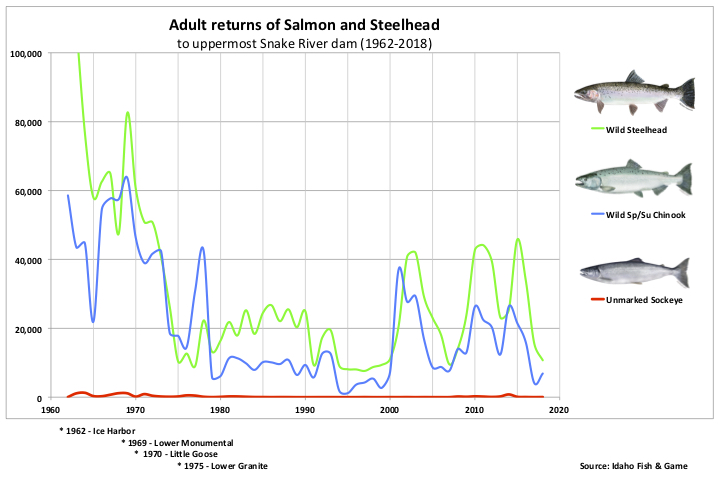forum
library
tutorial
contact

Why Bonneville Can't Save Salmon
by Tom KarierSpokesman Review, August 18, 2019
|
the film forum library tutorial contact |

|
Why Bonneville Can't Save Salmonby Tom KarierSpokesman Review, August 18, 2019 |
 The Northwest is not winning the battle to save wild salmon and steelhead in the Columbia River. Although most of the 12 listed salmonid stocks in the basin demonstrated a weak upward trend for a couple decades, that progress has stalled. Total returns of salmon and steelhead passing Bonneville Dam last year slipped to the second-lowest level in the past 18 years, and spring Chinook returns were 60 percent of the 10-year average. This year, they were only 37 percent.
The Northwest is not winning the battle to save wild salmon and steelhead in the Columbia River. Although most of the 12 listed salmonid stocks in the basin demonstrated a weak upward trend for a couple decades, that progress has stalled. Total returns of salmon and steelhead passing Bonneville Dam last year slipped to the second-lowest level in the past 18 years, and spring Chinook returns were 60 percent of the 10-year average. This year, they were only 37 percent.
Everyone agrees that part of the decline can be blamed on ocean conditions. But is it too much to expect some sign of progress from Bonneville's fish and wildlife efforts that now exceed a cumulative cost of $15 billion over 40 years?
After 20 years representing Washington state on the Northwest Power and Conservation Council, I no longer expect Bonneville to save wild salmon and steelhead. Here's why.
The first reason is the Bonneville Power Administration. Its idea of a salmon recovery program is to give states and tribes hundreds of millions of dollars in exchange for pledging to not sue Bonneville in federal court. However, as recent fish returns demonstrate, refraining from suing Bonneville doesn't necessarily produce more salmon. It also doesn't guarantee success in court as Bonneville continues to lose in the 9th U.S. Circuit Court of Appeals, casting suspicion on the basic strategy. These deals -- memorialized in the Columbia Basin Fish Accords signed in 2008 by three federal agencies, three states and seven tribes -- are posted on Bonneville's website.
Alternatively, Bonneville could have taken its role seriously as manager of the largest recovery program in the nation. It could have included performance goals in its fish contracts requiring actual results, such as more fish for harvest, more fish on spawning grounds and higher levels of productivity in restored habitat. Instead, Bonneville chose to require legal compliance rather than biological outcomes. It may have been easier as a power marketing agency to buy friends than performance, but it may not have been better for fish.
The second problem is that Bonneville's budget priorities reflect political compromises rather than fish priorities. Most of Bonneville's money is spent on overhead, planning, studies, contracting, coordination, research, monitoring and evaluation. Precious few dollars flow into on-the-ground projects that have any hope of saving salmon. Research and monitoring, for example, have accounted for as much as 40 percent of Bonneville's entire fish budget. Some of this is necessary, but most of it takes money from high-priority actions such as restoring floodplains, protecting cool-water refuges, removing culverts, protecting water flows and creating the type of habitat and safe passage that salmon need.
 A serious salmon recovery program with strict performance standards and reporting obligations may not engender the friendships that Bonneville seeks. But if done fairly and intelligently, it should produce more fish, and that would deserve some respect. But this alone would not be enough. There remains the issue of harvest.
A serious salmon recovery program with strict performance standards and reporting obligations may not engender the friendships that Bonneville seeks. But if done fairly and intelligently, it should produce more fish, and that would deserve some respect. But this alone would not be enough. There remains the issue of harvest.
Unlike almost any other endangered species, salmon and steelhead continue to be exposed to a legal harvest that can kill up to 8 percent to 45 percent of the run depending on the species. If ocean harvest is included, the numbers are higher still. Even the much-celebrated Snake River sockeye, whose returns dropped to single digits in the 1980s, can be exposed to harvest impacts of up to 8 percent. Harvest is seldom debated because it is broadly supported by federal and state agencies, federal courts, sport fishermen, commercial fishermen and businesses that make and sell fishing gear. It is true that harvest impacts are a ceiling and not always achieved and are lower than they once were, but that doesn't mean they are benign.
What is the effect of harvest? Essentially, salmonid populations listed as threatened or endangered need to exceed the spawning population by 8 percent to 45 percent every year just to stay even. And in recent years they haven't done that. If by chance more fish show up, the harvest formula ratchets up to the highest levels. If that doesn't guarantee growth will stall, it certainly makes it much harder to recover salmon.
Salmon are famously resilient. Despite dams, gill nets, barbed hooks, polluted waters, dried-up creeks and introduced nonnative predators, they continue to survive in the Northwest. But current efforts are not working, and we are no closer to recovering most of these salmon and steelhead species today than we were two decades ago. We have proven that salmon cannot be recovered with an expensive but inefficient recovery program coupled with high harvest rates. What we haven't tried yet is an efficient recovery program combined with harvest levels that make sense for endangered species.
Related Pages:
Dam Breaching Isn't So Simple by Tom Karier, Spokesman Review, 7/12/19
Two Long-Serving Members of NW Power/ Conservation Council -- Karier, Booth -- Retire by Staff, Columbia Basin Bulletin, 1/11/19
learn more on topics covered in the film
see the video
read the script
learn the songs
discussion forum
